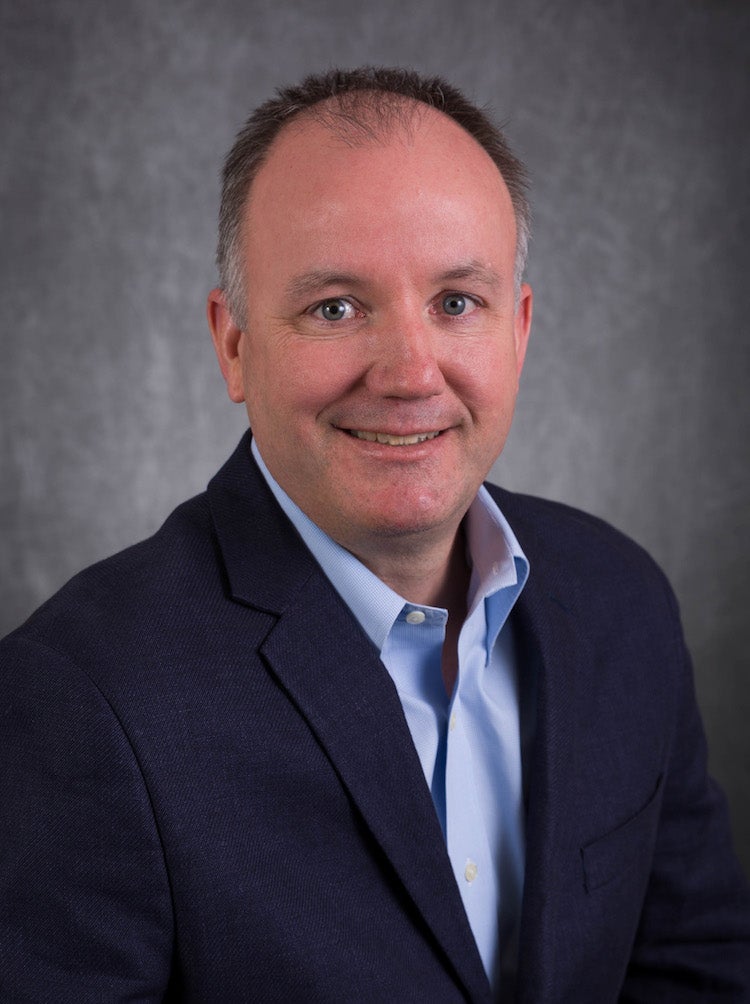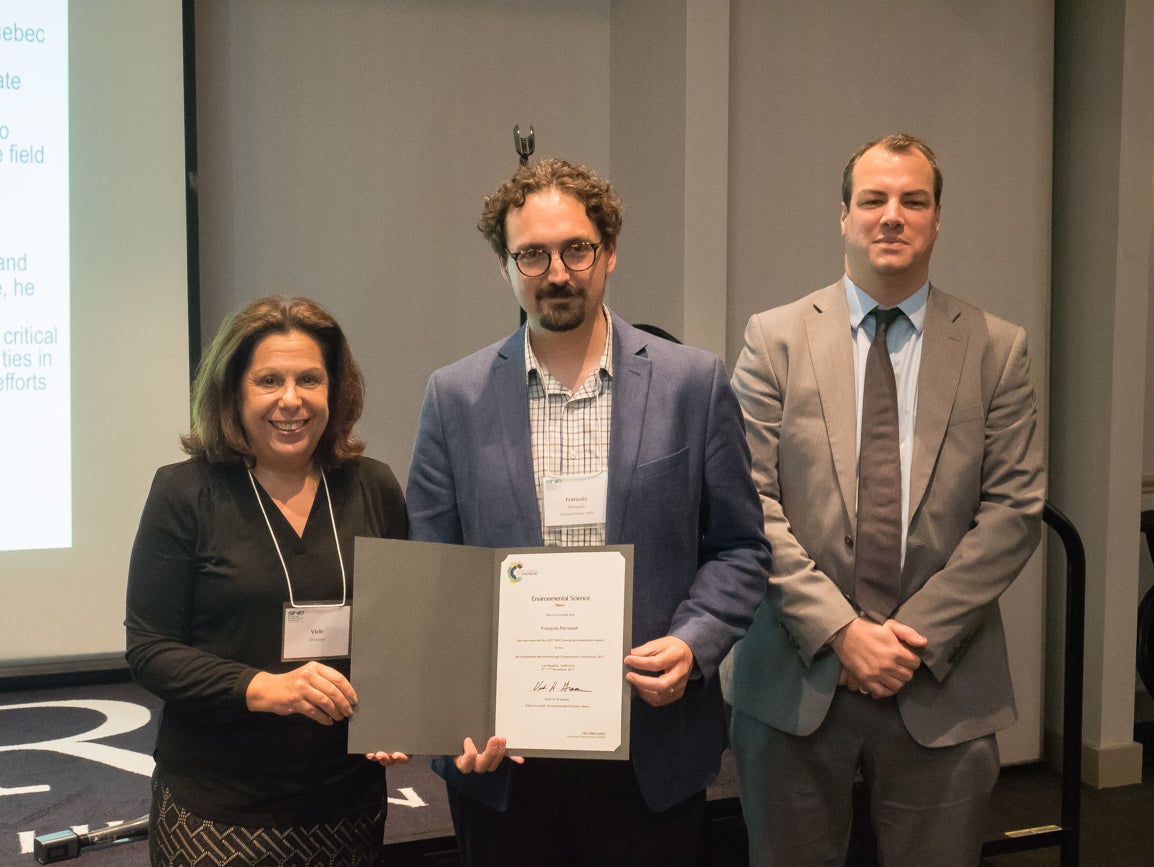Making sustainable strides in nanotechnology

Doctoral student Douglas Rice won awards for both a nanotechnology research poster competition and a Nano Pitch to judges on a research project proposal. Photo by Ana Barrios/ASU
A leading international society of nanotechnology professionals recently gave its top awards for research to two faculty members and a doctoral student in Arizona State University’s Ira A. Fulton Schools of Engineering.
The Sustainable Nanotechnology Organization honored ASU Regents’ Professor Paul Westerhoff with its annual award for significant research contributions to the field, while Assistant Professor Francois Perreault won the Emerging Investigator Award.
Douglas Rice, who is pursuing a doctoral degree in the Civil, Environmental and Sustainable Engineering program, received awards for research poster presentation at the annual SNO conference and for a “Nano Pitch” competition, in which participants are given 100 seconds to “sell” judges on the value of their research projects.
Westerhoff, who is also the Fulton Schools’ vice dean for research and innovation, was recognized for more than a decade of contributions to research aimed at advances in water treatment and improving water quality and safety through nanotechnology solutions.
In work that has often involved collaborations with biologists, chemists and sociologists, Westerhoff has helped to make strides in understanding the potential effects of nanomaterials in water and explored the use of nanomaterial-based technologies for water reuse and treatment, including the removal of pollutants.
His research has been supported by the U.S. Environmental Protection Agency, the National Science Foundation and the Department of Defense, among other major funding groups and agencies.
Westerhoff is currently the deputy director of the NSF Nanosystems Engineering Research Center for Nanotechnology Enabled Water Treatment where he conducts research using the novel properties of nanomaterials — such as optical and selective binding — to purify water. He also leads the center’s Testbed activities that aim to safely scale up technologies to accelerate the pace of their commercialization with the center’s industry members.
Work that has contributed to advances in water treatment and quality earned ASU Regents’ Professor Paul Westerhoff the Sustainable Nanotechnology Organization’s top annual research award.
Westerhoff and Perreault are both faculty members in the School of Sustainable Engineering and the Built Environment in the Fulton Schools.
Perreault’s Emerging Investigator Award recognizes researchers who within a decade of earning their doctoral degrees are making impacts in the field of sustainable nanotechnology that bring environmental, societal or economic benefits.
The award also notes Perreault’s role in nanotechnology education, including teaching a graduate-level environmental nanotechnology course and conducting education outreach activities for high school students.
He has published 40 peer-reviewed articles in research journals that focus on areas of nanotechnology. Many of the findings reported in those articles have been cited frequently for their importance in research publications by numerous fellow engineers and scientists.
His string of influential research publications started with articles that stemmed from his graduate studies thesis project, which won him a leading award for doctoral students who demonstrate outstanding expertise in biochemical toxicology.
Perreault went on to earn further recognition for applying his understanding of the cellular interactions of nanomaterials to the sustainable design of antimicrobial surfaces, and for research on the use of graphene nanomaterials in membrane-based water treatment.
He is now on the editorial board of the Environmental Toxicology and Chemistry journal, and he earned an Exceptional Reviewer Award from that journal in 2016. He is also a frequent reviewer for several other prominent nanotechnology-related research journals.
Research by Assistant Professor Francois Perreault (center) has had a significant impact on the use of nanomaterials in a variety of biological, chemical and environmental processes, including those related to water treatment. Photo courtesy of Kyle Doudrick/Sustainable Nanotechnology Organization
Perreault's current work, some of it supported by the NSF, involves the development of new nanotechnologies used in various biological, chemical and environmental processes.
Rice, whose research is being conducted under Perreault’s guidance, entered one of the more than 40 research poster presentations — predominantly from students — in the conference poster competition. He was one of about 20 students to participate in the “Nano Pitch.”
Rice won the first-place awards in the competitions for his presentations on research into biofouling, which is the growth of microorganisms that attach themselves to material surfaces — a common problem in water treatment.
The bacteria growing in treatment plants and distribution systems form structures called biofilms that clog equipment and increase the friction in the system, resulting in less efficient water treatment.
Rice says he is attempting to “reduce the impact of biofouling by modifying feed spacers with nanomaterials.”
Feed spacers help treat water by reverse osmosis or nanofiltration, processes that are becoming increasingly important as utility providers turn to nontraditional sources for drinking water, such as the ocean, or wastewater.
“Feed spacers provide a channel for the salt water to flow through, as well as encourage this water to cross the reverse osmosis membrane, leading to fresh water that can be safely used by people,” he said.
Fouling on the spacers has a big impact on the resistance within the treatment system, and increases the energy required to treat water.
“Through our research we have been able to improve the performance of the feed spacers using silver, which kills bacteria,” he said. “The project has also helped us to better understand what properties contribute most to a material’s ability to withstand biofouling.”
The SNO conference gave Rice opportunities to learn about cutting-edge nanotechnology work and to interact with peers and top researchers in the field.
“The unique properties of nanomaterials offer advantages over many traditional chemical and engineering processes,” he said, “and I would love to apply these properties in positive ways during my career.”
More Science and technology

ASU-led space telescope is ready to fly
The Star Planet Activity Research CubeSat, or SPARCS, a small space telescope that will monitor the flares and sunspot activity…

ASU at the heart of the state's revitalized microelectronics industry
A stronger local economy, more reliable technology, and a future where our computers and devices do the impossible: that’s the…

Breakthrough copper alloy achieves unprecedented high-temperature performance
A team of researchers from Arizona State University, the U.S. Army Research Laboratory, Lehigh University and Louisiana State…



